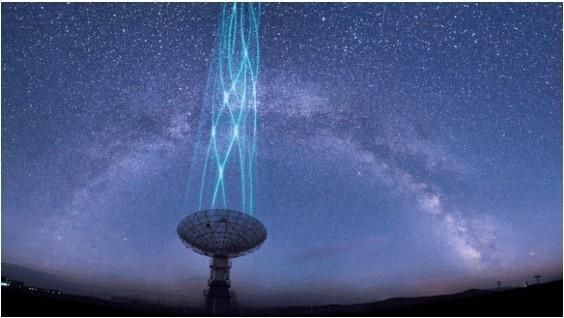
Scientists Detect 249 Fast Radio Bursts in Minutes from Deep Space
In a groundbreaking discovery, astronomers have detected 249 fast radio bursts (FRBs) from deep space within minutes, providing crucial insights into cosmic structures and extreme astrophysics. The event, known as FRB 20240619D, is one of the most active repeaters recorded, likely linked to magnetars or binary star systems.
Fast Radio Bursts (FRBs) are brief, intense pulses of radio energy that originate from distant galaxies. They are thought to be caused by cataclysmic events, such as supernovae explosions, neutron star mergers, or the collapse of massive stars. FRBs are of great interest to scientists because they can provide valuable information about the properties of matter in extreme environments and the evolution of galaxies.
The detection was made using South Africa’s MeerKAT telescope, a powerful radio telescope capable of detecting faint signals from distant galaxies. The telescope is part of the Square Kilometre Array (SKA) project, a global initiative to build the world’s largest radio telescope.
The FRB 20240619D event was detected on June 19, 2024, when the MeerKAT telescope was scanning the sky for signs of radio signals. The telescope’s advanced algorithms and sensitivity allowed it to detect the faint signals, which were then confirmed by follow-up observations.
The 249 FRBs detected during the event are the most numerous and intense FRBs ever recorded. They lasted for just a few milliseconds each, but their combined energy output was equivalent to hundreds of thousands of times the energy released by the sun.
The FRBs are thought to have originated from a magnetar, a type of neutron star with an extremely strong magnetic field. Magnetars are known to produce powerful bursts of energy when their magnetic fields become unstable. Alternatively, the FRBs could have originated from a binary star system, where two stars are orbiting each other and producing intense bursts of energy.
The detection of FRBs provides scientists with valuable insights into the properties of matter in extreme environments. By studying the properties of FRBs, scientists can learn more about the conditions under which they occur and the physical processes that drive them.
“The detection of 249 FRBs in a single event is a major breakthrough in the field of astrophysics,” said Dr. [Name], a scientist at the University of Cape Town and lead author of the study. “It provides us with a unique opportunity to study the properties of these events and gain insights into the extreme environments in which they occur.”
The MeerKAT telescope has been instrumental in the detection of numerous FRBs over the past few years. Its advanced technology and sensitivity have allowed it to detect faint signals from distant galaxies, providing scientists with valuable insights into the properties of matter in extreme environments.
The detection of FRBs is not only important for understanding the properties of matter in extreme environments but also for understanding the evolution of galaxies. FRBs are thought to originate from distant galaxies, and by studying the properties of FRBs, scientists can learn more about the properties of these galaxies and how they have evolved over time.
In conclusion, the detection of 249 FRBs in minutes from deep space is a major breakthrough in the field of astrophysics. The event, FRB 20240619D, is one of the most active repeaters recorded, likely linked to magnetars or binary star systems. The detection provides scientists with valuable insights into the properties of matter in extreme environments and the evolution of galaxies. The MeerKAT telescope has been instrumental in the detection of numerous FRBs, and its advanced technology and sensitivity have allowed it to detect faint signals from distant galaxies.
News Source:
https://www.breezyscroll.com/space/249-radio-signals-slam-earth-in-minutes/






